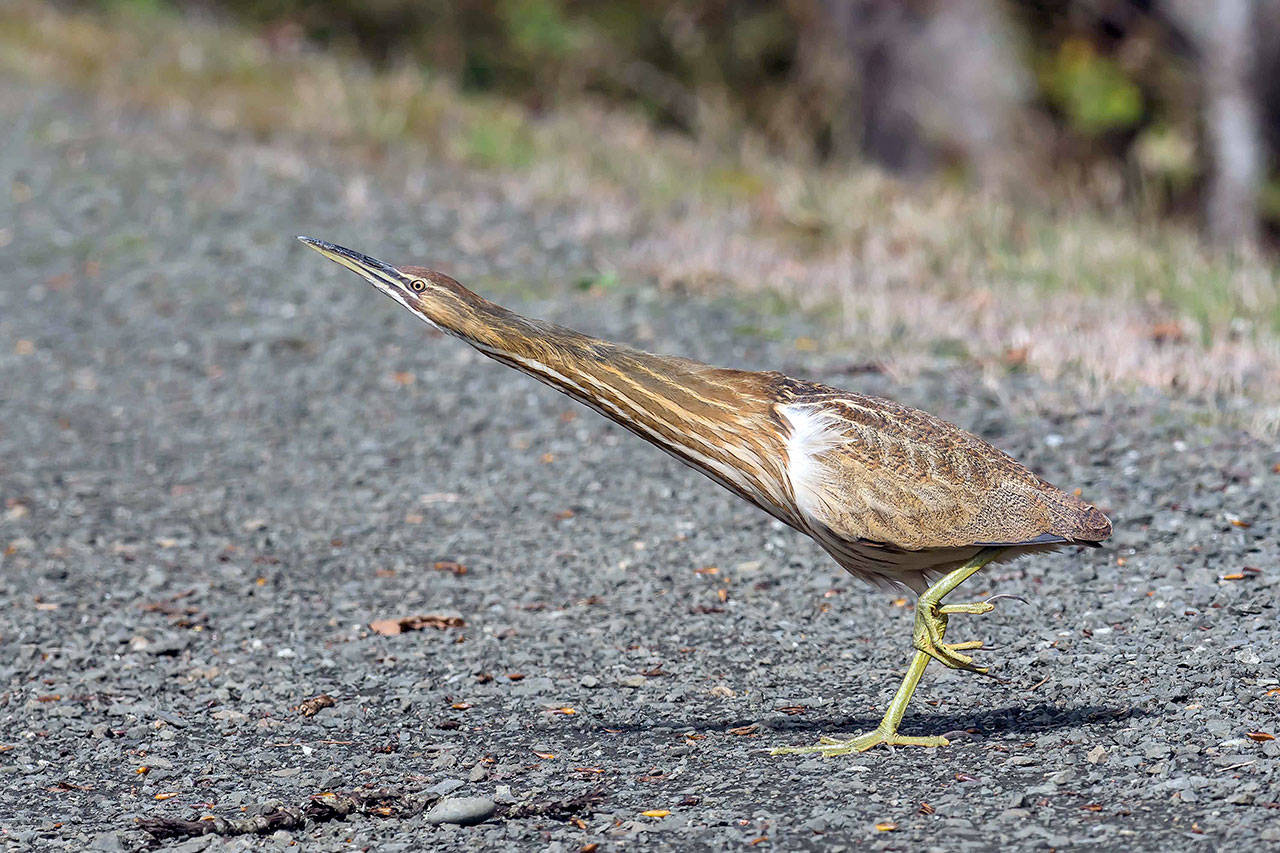By Dianna Moore
Grays Harbor Audubon Society
This could easily be a birders answer to the “What’s wrong with this picture?”
In this photo by Gregg Thompson this bird is assuming a “freeze” position, one that it uses to blend in with its normal surrounding of reeds and tall grasses. Consequently it sticks out like a sore thumb on this dirt and gravel background! It’s a very unusual thing to see, even in the reeds and grasses, just because it does so well at camouflaging itself. It even sways its neck to simulate a breeze passing through. Many times the bird makes its presence known by the peculiar gulping sound it makes but is never spotted thanks to the excellent cover.
General Description: Despite the slender appearance of this bird, the American Bittern is a stocky heron with mottled buffy-brown plumage, vertical brown stripes down its neck, a long powerful bill, and sturdy legs somewhat shorter than most herons. Adults have a dark stripe that runs from under the eye down the side of the neck. The bird can pull its neck in to appear short and sturdy or extend it to appear long and slender. Both sexes are twenty-three to thirty-three inches in length, with a wing span of about three feet, and weigh thirteen to eighteen ounces.
Habitat: Winter habitat for the American Bittern is dense cattail and bulrush marsh and wetlands, particularly around the edges of ponds and lakes. Though they prefer fresh-water areas, they will also take to flooded willow and salt marshes in winter. They are rarely caught out in the open.
Behavior: American Bitterns stand still at the edge of the pond, watching for prey in the water, then stabbing out with that long bill as do other herons. They are more active at dawn and dusk, often slowly walking in shallow water or just standing quietly, swaying slightly in the breeze with the reeds around them. It is more commonly heard than seen, with a loud gulping sound described as sounding like a water pump.
Diet: American Bitterns eat fish, insects such as water striders, giant water bugs, water beetles, water scorpions, grasshoppers, and especially dragonflies, crustaceans, amphibians, reptiles, and small mammals. They regurgitate a pellet to get rid of anything indigestible.
Nesting: American Bitterns nest in a dense marsh among thick stands of cattails, bulrushes, and sedges. Less commonly, they nest on dry ground, in grassland areas dense with tall herbaceous plants.The male defends the territory but the female builds the nest, usually on a raised platform of marsh vegetation, and lines it with dried grasses. She alone incubates two to seven eggs for about twenty-four days, regurgitates food for the young, then when the young leave the nest after about seven to fourteen days, she continues to feed and care for them for another four weeks. They can fly at about seven to eight weeks.
Migration: In milder areas, where water doesn’t freeze, the population stays year-round. In the farther northern latitudes, they are strongly migratory, leaving in late September or early October and returning in late April to early May. Managed wetlands, such as wildlife refuges, seem to be very important to their winter habitat.
Conservation Status: Because the American Bittern is such a secretive bird, we really don’t know what their population is, but we do know it is declining due to wetland habitat loss and degradation throughout the United States. Recreational boaters and acid rain are also causing stress on the breeding grounds.
When and Where to Find on Grays Harbor: The American Bittern can be found year-round in the remaining marshlands surrounding the streams, ponds, and lakes around the harbor. As with most birds, the best way to observe this heron is to find a quiet place to settle in and watch … a car is a perfect blind from which to observe a location. Watch for slow and stealthy movements along the shoreline, or listen for the wonderful “galumping” sound of it’s call. Particular favorites are the stands of cattails in drainage ditches and the tall marsh grasses along the edges of lakes, sewage treatment ponds, and ponds in fields.


